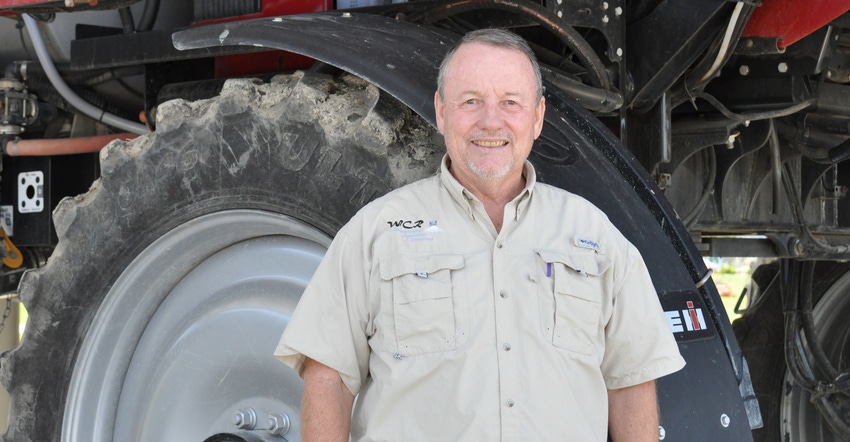March 15, 2018

Keeping in-season dicamba herbicide on target this season may be the only way to save the technology beyond 2018. That’s not an easy task, says chemical application expert Bob Wolf, and the best way to reduce drift potential is to start with the right nozzle.
Picking a nozzle from an approved list may sound simple, but Wolf says the EPA-approved list wasn’t created with optimum weed control in mind (see end of story: EPA’s dicamba label approval process). When low-drift goals merge with proper coverage, it causes some red flags.
Wolf shares five concerns about nozzles, pressure and spray volume, and how they relate to speed and boom height:
1. Some approved nozzles don’t match the 24-inch boom height requirement. Two of TeeJet’s air-induction nozzles are on the XtendiMax and FeXapan approved nozzle list, but the manufacturer-recommended 30-inch boom height for the 80-degree fan angle would be off-label. Applicators should cross-check their nozzle choice with all label requirements, including boom height and spray pressures, even if the nozzle is on the approved list.
2. The nozzles listed on the XtendiMax, Engenia and FeXapan requirement websites were selected based on drift reduction capabilities, not efficacy potential. Wolf says not every chemical, adjuvant and drift reduction agent (DRA) combination was field-tested for approval (see below). Some approved nozzles have corresponding low pressures that may result in weaker spray patterns, larger droplets and poor coverage. Use the pressure gauge as your speedometer, and maintain a pressure between 40 psi and 65 psi to create uniform patterns with nondrifting spray droplets and adequate coverage for weed control.
Wolf crafted these guidelines for 15-inch and 20-inch boom spacing to help applicators find the right on-label nozzle, orifice size, speed and operating pressure combination.
 REDUCE DRIFT: “The best chance you have at drift reduction is the nozzle,” Bob Wolf explains.
REDUCE DRIFT: “The best chance you have at drift reduction is the nozzle,” Bob Wolf explains.

3. Restricting sprayer speeds around field edges is virtually impossible. The labels recommend running sprayers at 5 mph along the treatment area edge, but Wolf says when conventional rate-controlled sprayers calibrated at 15 gallons per acre at 15 mph drop to 5 mph, the low pressure will result in larger droplets or cause nozzles to stop altogether. Certain DRAs can “confound the problem” (see No. 5). Wolf says slowing down is good, but be aware of the spray pattern implications.
4. Labels require two DRAs in some cases. The XtendiMax, FeXapan and Engenia labels require an approved DRA if certain chemicals or adjuvants, including drift reduction adjuvants, are added to the tankmix. “It doesn’t make agronomic sense to me that some of the things on the list have to be combined with a DRA,” Wolf says. And it costs more. “Why add two DRAs when one can do the job?”
5. Choose your nozzle and DRA wisely. “Not all nozzles will perform the same with all tankmix products,” Wolf says. The updated 2018 XtendiMax and FeXapan online application requirements carry this new warning: “Nozzle selection is one of the most important parameters for drift control. Not all drift reduction additives are compatible with every nozzle type and pesticide/adjuvant combination.”
Check with your DRA or additive manufacturer to ensure nozzle compatibility prior to application season.
Wolf understands the challenge of applying in-season dicamba according to label requirements, but he reminds all applicators that the label is the law. “Not following the label can lead to consequences that neither applicators nor the application industry wants.”
EPA’s dicamba label approval process
Wolf says the complicated XtendiMax, FeXapan and Engenia label requirements stem from EPA’s approval process and priorities. “During my conversations with the EPA last summer, I learned they had no concerns over weed kill,” he explains. “Their No. 1 goal was to protect endangered species.”
EPA views low particle drift, not weed control, as the top priority for the label requirements and nozzle, chemistry, adjuvant and DRA approval.
Every nozzle and potential chemical, adjuvant and DRA included in the tankmix has a drift profile based on wind tunnel testing data. EPA uses that data in the USDA’s drift-predicting Agricultural Dispersal, or AGDISP, Model. Any nozzle and tankmix combination with a drift profile equal to or less than the first-approved TTI11004 nozzle at 63 psi, which has low drift potential, makes the cut. Registrants (Monsanto, BASF and DuPont) manage the expanding approved nozzle and tankmix lists on websites that are considered an extension of the labels and the law.
“My concern is that the approved items are based on wind tunnel testing and modeling to meet the ‘low drift’ concerns and not necessarily something that has been field-tested,” Wolf says. “It is my opinion that not all the ‘approved’ combinations make sound agronomic sense from an application perspective.”
You May Also Like




